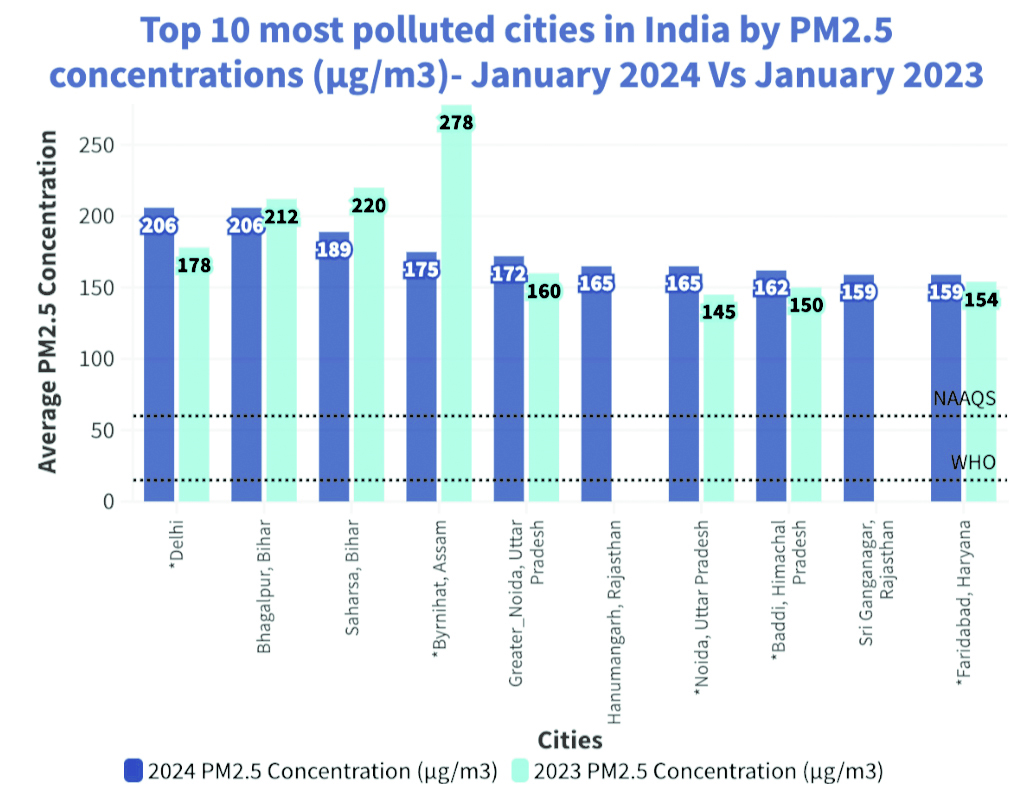In the span of six years, the number of Continuous Ambient Air Quality Monitoring Stations (CAAQMS) in India has significantly increased from 110 stations in 2018 to 539 stations spread across 271 cities by January 2024. However, challenges persist in ensuring comprehensive coverage and real-time data availability.
The National Clean Air Programme (NCAP), launched in January 2019, aimed at addressing air quality concerns in 102 non-attainment cities, later expanded to 131 cities. Yet, only 101 of these identified cities have functioning CAAQMS as of January 2024, leaving 30 cities without transparent real-time pollution information.
Out of the 271 cities equipped with CAAQMS, 255 had over 80% data availability in January 2024. However, 11 cities experienced less than 20% data availability, and five cities had no recorded data despite the presence of CAAQMS.
January 2024 revealed alarming air quality issues, especially in NCAP cities. Monthly average PM2.5 levels exceeded the World Health Organization’s (WHO) daily guideline in 98 NCAP cities. Only 32 cities met India’s daily National Ambient Air Quality Standards (NAAQS), while 66 cities recorded PM2.5 concentrations surpassing the NAAQS, with 15 cities exceeding the prescribed standard.
Among the 157 non-NCAP cities with over 80% data availability, only three cities—Satna (Madhya Pradesh), Mandikhera (Haryana), and Gangtok (Sikkim)—reported PM2.5 levels below the WHO daily guideline. Sixty-eight cities adhered to the daily NAAQS, while 89 cities experienced air quality poorer than the NAAQS, including 17 cities with pollution levels at least twice the daily NAAQS.
In January 2024, only ten out of 98 NCAP cities achieved full compliance with the daily NAAQS for PM2.5 concentration, while 17 cities consistently failed to meet the standard. Furthermore, 85 NCAP cities recorded PM2.5 levels exceeding the WHO-prescribed daily guideline throughout the month.
Among the 157 non-NCAP cities, only 23 achieved 100% compliance with the NAAQS for all days of January, while 25 cities exceeded the NAAQS every day. Eighty-three cities among the 157 recorded at least 15 days with PM2.5 levels surpassing the daily NAAQS, and 104 cities consistently exceeded the daily WHO guideline.
Northern states in India, particularly in the Indo-Gangetic Plain (IGP) region, experienced hazardous PM2.5 concentrations due to stable atmospheric conditions caused by low wind speed and cooler temperatures. Conversely, cities in southern regions exhibited PM2.5 concentrations below the NAAQS, emphasizing regional variations in air quality.
Ranking of the top 10 most polluted and cleanest cities in India
In January 2024, Delhi claimed the unenviable title of the most polluted city in India, closely trailed by Bhagalpur, both registering a monthly average PM2.5 concentration of 206 µg/m³.
This exceeded the daily National Ambient Air Quality Standards (NAAQS) throughout the month. Among the top 10 polluted cities, Bihar had two representatives, as did Rajasthan, Uttar Pradesh, Assam, Haryana, Himachal Pradesh, and Delhi.
After Delhi and Bhagalpur, the subsequent cities in the top 10 pollution list for January were Saharsa, Byrnihat, Greater Noida, Hanumangarh, Noida, Baddi, Sri Ganganagar, and Faridabad. Notably, this list included five Non-Attainment Cities under the National Clean Air Programme (NCAP) and five non-NCAP cities, highlighting the pervasive issue of hazardous air quality beyond the NCAP focus list.
All cities in the top 10 recorded PM2.5 concentrations well beyond double the NAAQS for at least 25 days, with none reporting a single day of good or satisfactory air quality. Two Rajasthan cities, Hanumangarh and Sri Ganganagar, lacked comparable PM2.5 concentration data from the Central Ambient Air Quality Monitoring Stations (CAAQMS) for the same month last year.
Among the remaining eight cities, five experienced higher PM2.5 concentrations in January 2024 compared to the previous year. However, Bhagalpur and Saharsa in Bihar showed a slight reduction, and Byrnihat, Assam, witnessed a significant drop of over 100 µg/m³.
Furthermore, the frequency of severe air quality days, defined as those with PM2.5 concentrations exceeding 250 µg/m³, notably decreased in Byrnihat, Saharsa, and Bhagalpur in January 2024 compared to January 2023.
In January 2024, 51 cities featured in the daily most polluted cities list, with 21 appearing at least five times. Bhagalpur led with the most appearances (29 days), followed by Delhi (28 days), Saharsa (21 days), Hanumangarh (14 days), Byrnihat, Greater Noida, and Chapra (13 days each). The daily top 10 most polluted cities list spanned across 13 states and union territories, emphasizing the widespread severity of hazardous air pollution nationally.
Only 20 out of the 51 cities in the daily top 10 most polluted list during January 2024 were part of the NCAP, leaving 31 cities without any action plan to reduce hazardous air pollution concentrations.
Contrastingly, Satna in Madhya Pradesh emerged as the cleanest city in India in January 2024, with a monthly average PM2.5 concentration categorizing all 31 days as ‘good’ (PM2.5 concentration lower than 30 µg/m³).
Following closely were Mandikhera in Haryana and Gangtok in Sikkim, both recording PM2.5 concentrations below the WHO daily guideline level of 15 µg/m³. Other cities in the top 10 cleanest cities list for January 2024 included Chamarajanagar, Vijayapura, Kalaburgi, and Bagalkot in Karnataka, along with Aizawl in Mizoram, Silchar, and Sivasagar in Assam.
Among the 36 states and union territories in India, only 29 had at least one city with a functioning CAAQMS providing data for more than 80% of the days in January 2024. The remaining territories either lacked installed CAAQMS or had inactive stations.
In January 2024, 23 out of 36 state/UT capital cities had at least one CAAQMS installed, with data availability exceeding 80% of the days. However, the remaining 13 capitals lacked real-time data on air pollution levels.
KEY HIGHLIGHTS
n As of January 2024, only 101 out of 131 cities identified as non-attainment cities under the National Clean Air Programme (NCAP) have functioning continuous ambient air quality monitoring stations (CAAQMS).
n The monthly average PM2.5 levels in 98 NCAP cities exceeded the World Health Organization’s (WHO) daily guideline for PM2.5 during the same period, with only 32 cities meeting India’s daily National Ambient Air Quality Standards (NAAQS).
n Delhi ranked as the most polluted city in India in January 2024, followed closely by Bhagalpur, Bihar. Notably, 51 cities featured in the daily most polluted cities list during the month, with Bhagalpur appearing the most times (29 days).
n Among the 157 non-NCAP cities with over 80% of days having CAAQMS data, only three cities—Satna (Madhya Pradesh), Mandikhera (Haryana), and Gangtok (Sikkim)—reported monthly average PM2.5 levels below the WHO daily guideline.
n In contrast, 68 cities adhered to the daily NAAQS, while the air quality in the remaining 89 cities exceeded the NAAQS.
n Stable atmospheric conditions due to low wind speed and cooler temperatures in northern India contributed to the accumulation of pollutants near the Earth’s surface, resulting in elevated ambient air pollution levels.
n Out of the 51 cities on the daily top 10 most polluted list, only 20 are part of NCAP, highlighting the need for urgent action plans to address hazardous air pollution concentrations in the remaining 31 cities.























